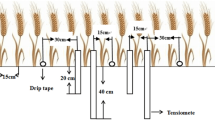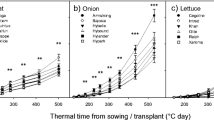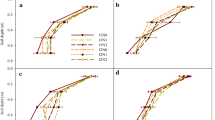Abstract
Root length density (LV), mid-day leaf water potential (Ψ leaf) and yield of wheat were studied in 1983 – 1984 and 1984 – 1985 on a Phoolbagh clay loam (Typic Haplaquoll) and on a Beni silty clay loam (Aquic Hapludoll) in the Tarai region of Uttar Pradesh under naturally fluctuating shallow (0.4 – 0.9 m, SWT) and medium-depth (0.8 – 1.3 m, MWT) water table conditions with six water regimes: rainfed (I0); irrigation at cown root initiation (I1); at crown root initiation and milk (I2); at crown root initiation, maximum tillering and milk (I3); at crown root initiation, maximum tillering, flowering and milk (I4); and at crown root initiation, maximum tillering, flowering, milk and dough (I5). Maximum rooting depth (0.8 m under SWT and 1.05 m under MWT conditions) was attained at the dough stage (115 days after sowing, DAS) and was more strongly influenced by fluctuations in water table depth than by the water regime. For wet regimes (I2– I5), roots were concentrated at and above the water table interface and had greater horizontal development, whereas in dry regimens (I0 and I1), due to deficient moisture conditions in the upper soil layer (0.45 m) they invaded lower horizons and had a greater vertical distribution Ψ leaf was not significantly affected by water regime (I1– I5) up to 94 DAS during a wet year (1983 – 1984) and up to 74 DAS during a dry year (1984 – 1985), but was significantly affected thereafter. Grain yields with water regimens I1– I5 during a wet year and for the I2– I5 treatments during a dry year at either water table depth were not significantly different, but there was a (non-significant) trend to lower yield with increasing soil water deficit. Under SWT in I2, the average grain yield wsa 5130 kg ha–1 and under the I3 regime, 5200 kg ha–1. Likewise, under MWT in I3, it was 5188 kg ha–1 and under the I4 regime, 5218 kg ha–1. The results indicate that application of irrigation of more than 120 and 180 mm under SWT and MWT conditions, respectively, did not raise yield. Irrigation given as per schedule I2 under SWT and I3 under MWT conditions in the Tarai situation, appears to be more effective than a very wet regime (I5).
Similar content being viewed by others
Author information
Authors and Affiliations
Additional information
Received: 9 December 1997
Rights and permissions
About this article
Cite this article
Mishra, H., Rathore, T. & Tomar, V. Root growth, water potential and yield of irrigated wheat. Irrig Sci 18, 117–123 (1999). https://doi.org/10.1007/s002710050052
Issue Date:
DOI: https://doi.org/10.1007/s002710050052




